Recent Updates
11/18/2025 12:00 PM
Vauxhall Mokka GSE
11/18/2025 12:00 PM
WATCH: Vauxhall Mokka GSE review - An EV crossover that really handles
11/18/2025 12:00 PM
Driving the Skoda museum collection
11/18/2025 12:00 PM
I didn't expect the Rocket to enter my ‘favourite cars of all time' list
11/18/2025 12:00 PM
MG S6 EV: Skoda Enyaq rival offers 329 miles of range for £38k
11/18/2025 12:00 AM
Taking a ride in London's first autonomous taxi
11/17/2025 12:00 PM
We test Peugeot's new Hypersquare steering system
11/17/2025 12:00 PM
Leasing giant targets cheaper EVs with used salary sacrifice scheme
11/17/2025 12:00 PM
Ford Focus production ends after 27 years
11/17/2025 12:00 PM
Ford Puma Gen-E gets bump in range for 2026 model
EV, Hybrid, Hydrogen, Solar & more 21st century mobility!

The Rapid was the first Skoda to be modelled in a wind tunnelSkoda DNA oozes from these historic cars
As the boss says, there’s “nothing that Skoda has not done yetâ€. This 130-year-old company founded by Václav Laurin and Václav Klement in Mladá Boleslav, then in the Kingdom of Bohemia, started out making and repairing bicycles but soon after added huge diesel static engines to its remit, their castings poured near the entrance of what is still today the wonderfully atmospheric Skoda museum.Â
The city is still Skoda’s headquarters. The base then remains the base now. In 1905 came the first car; it’s believed two working examples are still in existence and one is today phutting around the castle yard where I’m standing next to some other classic Skodas.
Soon L&K was the biggest car manufacturer in Austria-Hungary. But when we talk broad remits, it’s worth remembering that motorcycles came too, as did aero engines. The Skoda name was adopted when Laurin and Klement’s company was bought by Skoda Works in 1925, but the diversity didn’t stop then.Â
And yet, what defines Skoda today – its practical, sensible, good-value family cars – has long been a standpoint in the Skoda range, even when it was making the original V8-engined Superb, a car fit for royals and ambassadors.
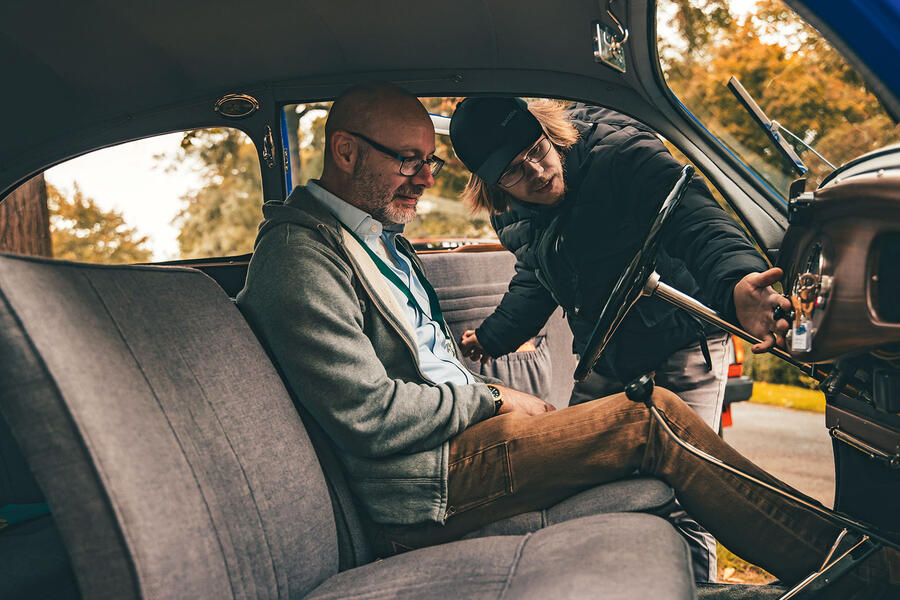
Take this Rapid, from 1940. It’s one of only five such cars remaining, but its streamlined shape – it was the first Skoda to be modelled in a wind tunnel – I find impossibly adorable. It’s a two-seat saloon car, called the Rapid OHV when it was launched in 1938 as a more aerodynamic follow-up to the 1935 Rapid on account of its overhead-valve 1558cc four-cylinder engine. Only 101 with this body type were made.
What the Rapid and the aforementioned Superb have in common is that they were among the first Skodas to use a backbone chassis, designed to be more rigid than early ladder-framed cars. But while the Superb dwarfs onlookers and other cars in the Skoda museum, in the grounds of Castle Loucen the Rapid lurks diminutively on a pedestrian pathway.
Its rear-hinged doors are opened wide and I’m ushered inside, onto squashy foam, low-backed seats. This car must have been restored at some point – it’s just too perfect, with tidy carpets and fabrics and a genuinely luxurious-looking wooden dashboard.
There is a smattering of switchgear on and around the dash, metal and Bakelite (or some equivalent) buttons and some straightforward engineering – long before they called it Simply Clever – left on display.
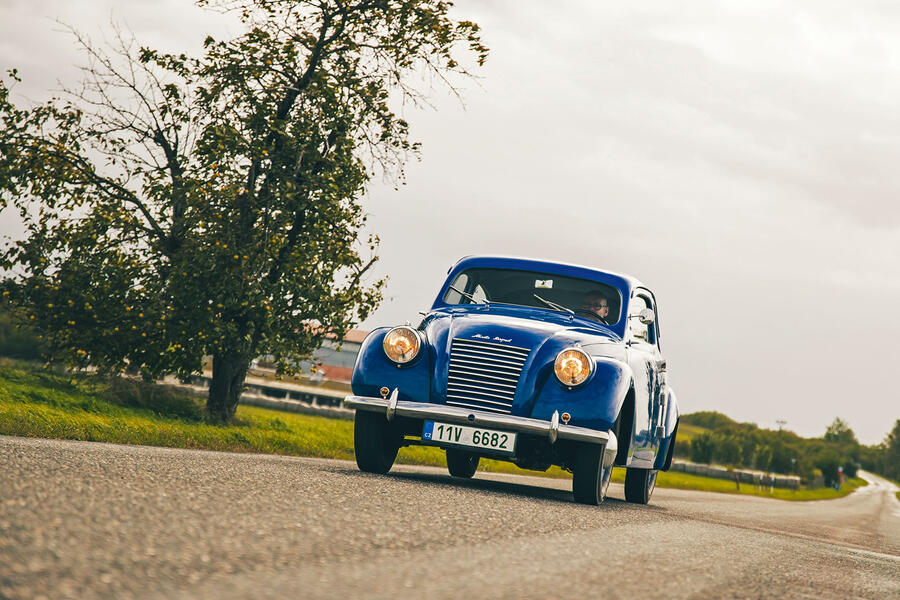
Above my head is a pull string for a rear window blind; the windscreen wipers are connected by a pushrod ahead of me, because only one is propelled by motor and the mechanism to drive the other is not hidden.
There are trafficators but, because these are illegal to rely on in today’s Czech Republic, indicators have been wired up to the lights and there’s a discreet switch beneath the dash to operate them.
The car fires from a twist of a key to set the ignition on, then via a push of a foot-operated starter button. Already slightly warmed through, it doesn’t need any throttle to get it going and it settles to an audible, respectably smooth idle.
By the 1930s, we had settled on the best way to place the controls in a car so there are clutch, brake and accelerator pedals where you would expect them; the throttle an oval, the other two effectively big round buttons protruding from the floor.
The H-pattern gearbox has three speeds and they’re marked on the gearknob just as in a car today – with reverse towards me and up, first towards me and down on a dogleg, and second and third on the right-hand plane. There is, I’m told, no synchromesh.
It takes time to make progress in a car like the Rapid. And that’s fine. What’s interesting, of course, is that everybody used to drive like this. The days of driving 40,000 motorway miles a year at a steady 70mph as a sales rep were decades into the future.

Cars weren’t the buy-and-forget consumer items they are today. They were still becoming the machine that changed the world. They took time and commitment to both look after and drive. I gingerly slot first gear – no embarrassing graunching – and tickle away.
One of the nice things about old cars is the amount of latent torque they seem to develop. It helps, of course, that the Rapid is low-geared and also won’t weigh a great deal, but this 42bhp car with its modest 62mph top speed eases out of the castle’s gravelled drive and onto the open road with hardly any throttle. I don’t spend long revving before shifting up a gear each time.
The Rapid’s steering is heavy, sticky and very slow, with no discernible self-centring either. But that’s only one of the dynamic elements that necessitates thought and planning. The unassisted brakes work in a mostly advisory capacity, and there’s double de-clutching and rev matching on the gearshifts to do as well, to make smooth and un-notchy progress.
Get that right and the Rapid is a joy to drive today. It’s not the sort of classic car one would drive as a daily (although one veteran owner has one he restored over 30 years as his only car), but you could drive it in modern traffic without embarrassing yourself.
It’s not like a car from the 1910s. I wouldn’t fancy doing its top speed in it, given the steering vagueness, but as a way to pootle around quiet roads between Czech farms, it’s a joy.
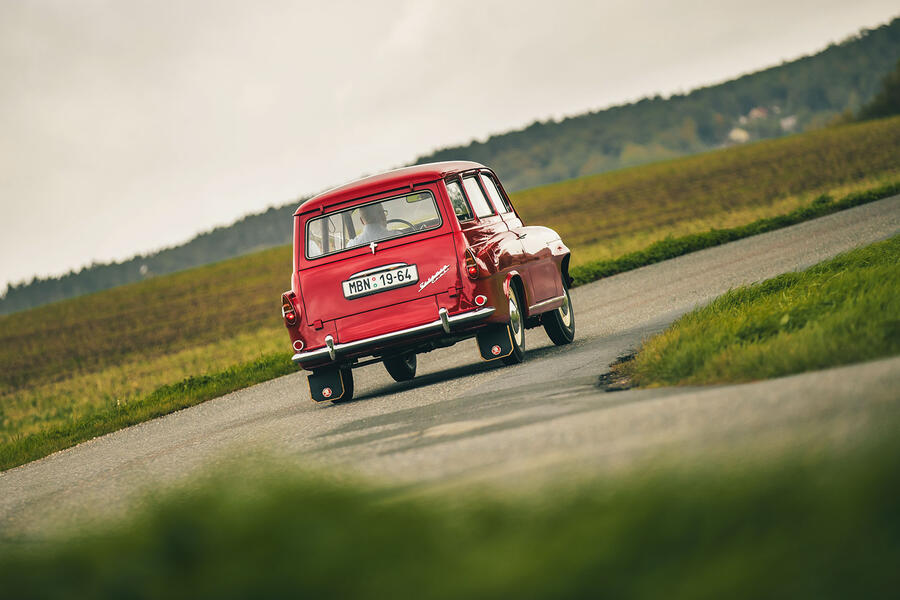
So much of that comes from the interior, I think: the quality of it, the style, the view out – particularly through the split rear window – and for a small car, there’s credible head room, elbow room and even space for a photographer to scooch into the back. I’ll admit I fell for it in quite a big way.
Skoda’s Octavia Combi of 1968 feels, perhaps inevitably, less special than the earlier car. We are now entering the territory where the car is a more ‘ordinary’ consumer item, and where there is competition and value for money is more fiercely contested.
But the Octavia – so named because it was the eighth car produced by the then nationalised Czechoslovak car maker – is still a dreamy-looking car to my eyes. I particularly like its proportions in profile; with a short front overhang and a trailing rear overhang, there’s a bit of space-age, dynamic purpose to it. Hints of – don’t laugh – Morgan Super 3.
It’s just over four metres long, the Octavia Combi, but what’s notable about it is not just that the Octavia name made such a successful comeback under later Volkswagen ownership, but also that it represents a huge success for Skoda in the Combi – estate car – field. The Octavia saloon was only made from 1959 to 1964, but the Combi version was launched in 1961 and stayed in production for a decade.
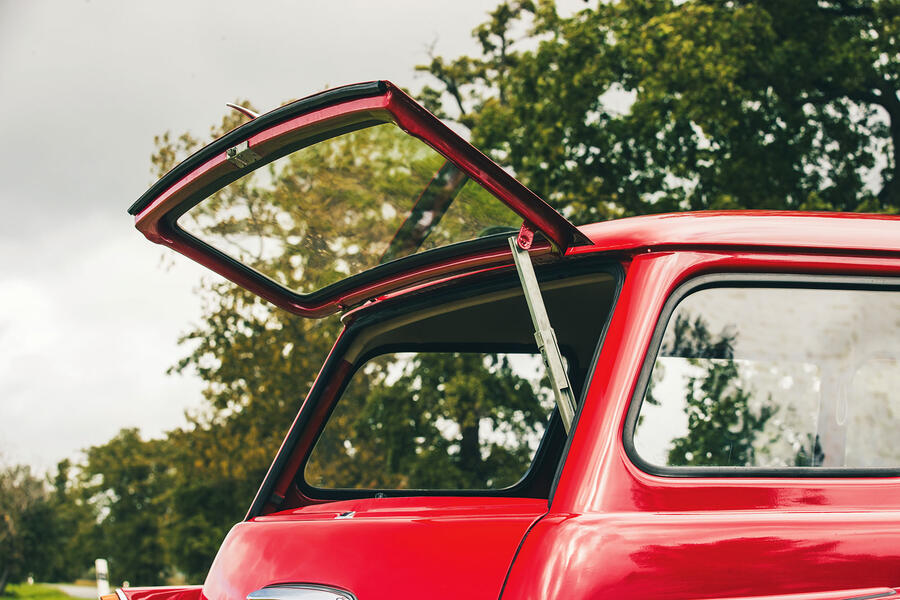
It was internationally successful too. Variants were assembled in Ireland, Chile and New Zealand, where the underpinnings found their way into the Skoda Trekka, a light utility vehicle that looks like a Lego interpretation of a classic off-roader.
If you wanted, you could make the case for it being one of the world’s first SUVs, launched as an agricultural-friendly vehicle but later popular with tradies and rural families.
But back to this Octavia and its simple white dashboard, part-vinyl, part-fabric low-backed seats (still no seatbelts) and again an elegant, big, thin-rimmed steering wheel. The wheel does things more convincingly and accurately than in the Rapid, and the driving position is still sound.
There wasn’t much wrong with it in the Rapid but this feels instinctively more modern. Trademark features of classic cars still abound, though. Visibility is fantastic and there’s a generous amount of head and shoulder room, plus room for rear occupants and a not inconsiderable boot behind a split tailgate.
That this all fits within four metres of length and 1.6m of width is a thing of wonder. I suppose the big difference between one of these cars and one with similar interior space today is that the later car would be the preferable one to crash in.
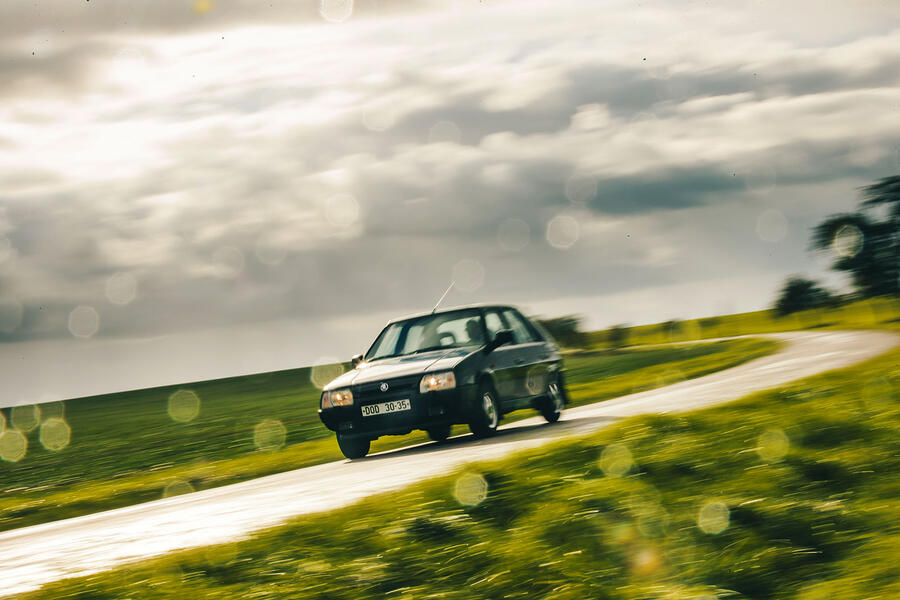
Aiding the airy, almost Cal-look feel, the gearlever is column-mounted, freeing up space on the floor. There is synchromesh and the brakes are servo assisted so the Octavia is a much easier car to drive than the Rapid, if you’re used to column shifts. I am not.
It takes me a moment to become comfortable with the fact that this four-speed ’box is an H-pattern just like it would be on the floor, just mounted on a different plane. That done, the 1.2-litre 50-ish-bhp Combi, capable of around 70mph but happiest at about 40mph, would make for a really usable, endearing and attractive classic car. (Alas, as I write, I can find none for sale.)
When the Octavia saloon was replaced in 1964, it was by the 1000MB, a rear-engined, rear-wheel-drive car – a layout that, despite the recent introduction of the front-engined, front-wheel-drive Mini, was still popular at the time. It meant that the engine, gearbox and driven wheels were all packaged close together, making for a spacious cabin, and it allowed for a low scuttle and thus good forward visibility and a small frontal area.
But it was a layout that would, eventually, be relegated to niche status, as manufacturers got to grips with setting up the front wheels so that they could deal with both steering and driving, and that meant more boot space.
Skoda stuck with the rear-engined layout longer than most but by the early 1980s, still government-owned, it wanted to replace its endearing rear-engined models with something much more modern, which meant front-engined, front-wheel drive, in a very conventional European hatchback style.

This Favorit – and, true to its name, it became one of central Europe’s favourite cars – was the result. It took a long time to develop, with styling by Bertone and some variants that never made it to production, but the car was produced from 1987 to 1994, and this late model is a lovely example. It wears its 100,000km (62,000 miles) really well and drives much like a modern car.
At only 3.8m long, it’s shorter than the Octavia Combi but feels more spacious inside, notably for the driver and front passenger. The steering and brakes are power assisted – the steering heavy only at very low speeds – and otherwise the controls are light and easy.
The five-speed gearbox is a particular joy.In contemporary testing, Autocar & Motor (as this magazine was then) said that the Favorit “always had the fundamentals of a great little car†with “the space and pace of the best [alternatives] but at two-thirds the normal priceâ€.
And while it doesn’t feel like a new car now, it certainly doesn’t feel like an old one. If you could find one in this condition, it would be a perfectly serviceable daily driver until the day its bodywork decided it wasn’t. And in its lightness, visibility and the way it lopes along, it would have the measure of many new cars.

Sure, it didn’t feel that special inside then, or particularly now – not like the Octavia or especially the Rapid. But Autocar knew that something felt special at the time, so did Skoda, and we weren’t the only ones. Key to Volkswagen’s interest in the company was the engineering integrity that Skoda had applied to making the Favorit. In fact, it tipped that interest into something else.
The adverts from 1993 told the story in a way that, alas, I fear too few adverts do today. “Volkswagen were so impressed, they bought the company,†ran one. “The £3,000,000,000 Skoda,†said another bold advertising headline, the price Volkswagen initially invested.
“The new Skoda,†those adverts signed off. The Favorit was a key part of it. And if three billion quid seemed like a lot of money to invest at the time, Skoda has repaid the commitment in droves.Â
